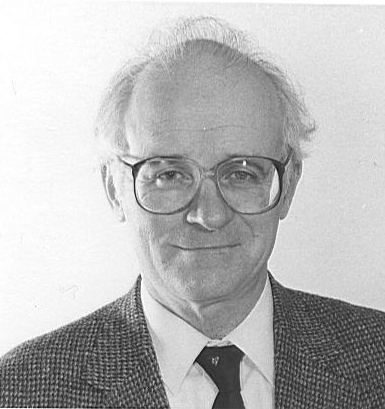 Bernard F. Burke, 1993 (NRAO/AUI/NSF image)
Bernard F. Burke, 1993 (NRAO/AUI/NSF image)
Bernard Flood Burke
Contributed by Ellen N. Bouton and Kenneth I. Kellermann
Bernard Flood Burke was born on 7 June 1928 in Brighton, Massachusetts and died on 5 August 2018. He received his undergraduate physics degree from Massachusetts Institute of Technology (MIT) in 1950, and his Ph. D. in physics from MIT in 1953 for work on microwave spectroscopy under Woody Strandberg. From 1953-1965 he was a staff member at Carnegie Institution of Washington Department of Terrestrial Magnetism (DTM), where he worked primarily on 21 cm research. In 1962 he became Chair of the DTM Radio Astronomy Section, and in 1965 he joined the MIT faculty as Professor of Physics, where he later became the William A. M. Burden Professor of Astrophysics. During his long tenure at MIT he supervised numerous doctoral students, many of whom have gone on to distinguished careers in radio astronomy and related areas.
During his long and productive career, Burke, together with his students, worked in a variety of areas of radio astronomy, including gravitational lensing, radio source surveys, exoplanets, and VLBI. In 1955, Burke, together with Ken Franklin, discovered the decametric radio bursts from Jupiter. He led the team that developed the first spectral line VLBI system, and was an early advocate of extending radio interferometer baselines to space. He is the co-author, along with Peter Wilkinson and F. Graham-Smith of the popular textbook, Introduction to Radio Astronomy.
Burke served in a number of important national and international leadership and advisory roles. He was a member of the National Science Foundation Astronomy Advisory Panel from 1958-1963, the NRAO Visiting Committee from 1958-1962, a Trustee for Associated Universities, Inc. from 1972-1990, and President of the AAS from 1986 to 1988. In 1985 he was appointed to the National Science Board by President George H. W. Bush. He also served on advisory Committees for the Keck Telescope, RadioAstron, the NASA Planetary Systems Working Group, and the Towards Other Planetary Systems Scientific Working Group, as well as serving on the NAS/NRC Space Studies Board and the Naval Studies Board. When away from science, Burke enjoyed racing his own sailboats and received several competitive awards.
Burke was a Fellow of the American Physical Society, the American Academy of Arts and Sciences, and the American Association for the Advancement of Science, a member of the International Astronomical Union, and the US National Committee of International Scientific Radio Union - Commission J. He received the AAS Helen B. Warner Prize in 1963, was the co-recipient of the 1971 Rumford Medal of the American Academy of Arts and Sciences, was the 1998 NRAO Jansky Lecturer, and in 1970, he became the first radio astronomer to be elected to the National Academy of Sciences.
![[IAU logo]](iau_wb_thumb.jpg)
![[URSI logo]](URSI-logo-thumb.jpg)
![[Karl Jansky at his antenna]](jansky_photo_02_thumb.jpg)
![[Reber's Wheaton antenna]](Reber_Telescope_Wheaton_thumb.jpg)
![[Dover Heights]](Dover_Heights_02_thumb.jpg)
![[4C telescope]](GB61-195_4C_telescope_thumb.jpg)
![[Ewen and horn antenna]](ewen_horn1s.jpg)
![[Dwingeloo, 1956]](Dwingeloo-1956-thumb.jpg)
![[Jocelyn Bell Burnell and Cambridge antenna used in pulsar discovery]](burnell2_thumb.jpg)
![[Lovell Telescope at Jodrell Bank]](site_1594_0001-500-334-20180316163019-thumb150.jpg)
![[Wilson, Penzias, and Bell Labs horn antenna]](wilson-penzias-horn_thumb.jpg)
![[6-m Millimeter Radio Telescope in Mitaka, Japan]](6m-thumb.jpg)

